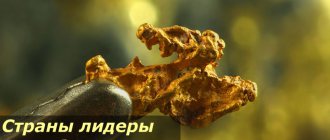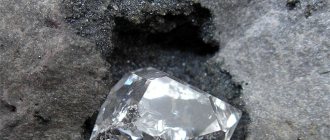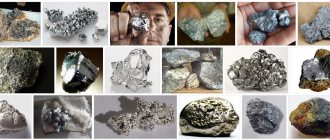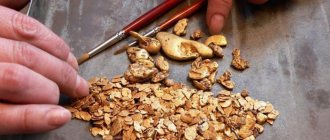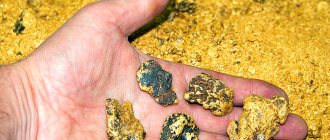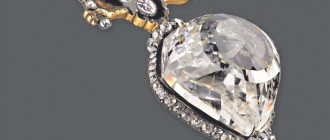Aluminum is an extremely light metal, but due to its characteristics, the raw material is used in many industries. It is used in aviation, shipbuilding, as well as the production of cars and ships. The use of aluminum became truly widespread during the Second World War.
To obtain the metal, bauxite is used, a resource whose extraction sources are found in 18 countries. As a rule, they are all characterized by a hot climate with sufficient moisture. In addition to bauxite itself, substitutes can also be used, but their use is less cost-effective. These include anorthosite, alunite, oil shale and other resources.
Which country is the leader in tin ore mining?
The world's main producers of tin are
China, Indonesia, Peru and Bolivia, whose combined share in global mining metal production exceeds 85%.
Interesting materials:
What happens if you wash clothes at 90 degrees? What happens if you wash viscose in hot water? What happens if you stop using iCloud photos? What happens if you cook frozen potatoes? What happens if you puncture your eardrum? What happens if you missed Vpr? What happens if you eat sour borscht? What happens if you eat chocolate that is a year expired? What happens if you eat fish and milk? What happens if you eat fresh cucumber with milk?
Description and properties of bauxite
What are the visual characteristics of metal? Bauxite, in simple terms, is aluminum ore. It contains aluminum hydroxide, as well as oxides of other metals (iron, silicon and others). Bauxite contains not only the usual components, but also alumina. Moreover, this element is present in the ore in a ratio of 40 to 60 percent. In any case, the natural material is unique.
Before talking about the future of bauxite, we should return to its origins. You could first hear about the material in 1855, when it was presented at an exhibition in France. Onlookers were presented with an unusual silver-colored stone. It was clearly different from other previously discovered rocks.
The weight of the rock is very small, but from a chemical point of view the material is highly durable. It was immediately dubbed “clay silver” because of its color and softness. We will talk about the main properties of the material. In this case, the raw material used to extract aluminum was called bauxite. Not all rocks are suitable for making metal. Only those bauxites in which the percentage of aluminum chernozem reaches 40 percent or higher are suitable for it. Therefore, deposits where the material is produced with particular ease quickly find owners and are profitable.
Visually, “aluminum” ore is similar to clay. But there is nothing in common between these materials, based on their characteristics. If clay dissolves in water, bauxite retains its proportions. The Russian Federation also has reserves of raw materials. The first deposit, located in the Urals, was called “Little Red Riding Hood”. Today it is difficult to imagine entire industries if aluminum had not been invented.
In which region of the world is the largest bauxite mining area located?
The largest in the world
bauxite
reserves , followed by Jamaica and Brazil.
Interesting materials:
How to call from landline to landline? Which razor gives a cleaner shave, rotary or foil? What will be the price of iPhone 12 in Ukraine? What was Gagarina like? Which bra cup is larger? Which part of speech is not classified as official? What part of the land is covered with forests? What part of the land is covered with water? Which part of Turkey is the warmest? What is the maximum radio frequency?
Links
- British Geological Survey complete list
- Map of countries and bauxite deposits in the world at the end of the 20th century
| Country comparison lists | |
| Geography Demographics | Area · Maximum heights · Minimum heights · Population (1900 · 2011 · forecast) · Population density · Urban population: number of millionaire cities · Population growth · Fertility · Mortality · Infant mortality |
| Sociology | Life expectancy · Quality of life · Human potential · Education · Literacy · General happiness · Minimum wage · Income inequality · Intentional homicide · Suicide · Age of sexual consent · Adulthood · Prisoners · Charity · Consumption of: alcohol (beer) · cigarettes · coffee · mobile phones · Internet (high-speed) · cars |
| Entrepreneurship Economics | Ease of doing business · Innovation · Number of patents · Production and extraction of: oil · gas · coal · uranium · electricity · automobiles · iron ore · steel · cast iron · bauxite · copper · aluminum · zinc · manganese · bismuth · cement · cellulose · paper and cardboard · wheat · rye · rice · barley · buckwheat · corn · potatoes · milk · fish · wine · apples · Transport: railways · roads · pipelines · inland waterways · shipping · airports · metro |
| Macroeconomics | Global competitiveness · GDP (nominal): per person · GDP (PPP): per person, forecast · Budget · External debt · International reserves · Gold reserves · Oil reserves · Current account balance · Trade balance · Exports · Imports |
| Politics Army Space | Great Powers Economic Freedom Freedom of Speech Democracy State Failure Peaceful Armed Forces Military Budget Nuclear Club (nuclear weapons) Space Club (launch rockets) Satellites Astronauts |
| Sport | FIFA World Cup: men · women · ranking · Futsal · Ice Hockey World Cup: men · women · ranking · Bandy World Cup · Davis Cup |
Australia
Australia, a continental country with an area of 7.6 million km², ranks 6th. The state is washed by the Pacific and Indian oceans, as well as 4 seas: Arafura, Coral, Timor and Tasman. There are few rivers in Australia. The largest - Murray - has a length of 2375 kilometers. Power stations are being built on the wild rivers of Tasmania. The artesian waters of the country are saturated with large amounts of salts. There are also many saltwater and freshwater lakes.
Australia is rich in mineral resources that exceed the world average by 20 times. The country ranks first in uranium reserves and second in bauxite reserves. There are also large deposits of coal, diamonds, manganese, and gold. Gas and oil reserves are insignificant.
The country is home to representatives of many nationalities. Australia is famous for its incredibly beautiful, mysterious underwater world, extraordinary fauna and flora. Due to the location of the continent in the southern hemisphere, the seasons are reversed - the cold season here is in the summer, and warm in the winter. The state has the largest pastures in the world. The country is a leader in the supply of wool and barley to the world market.
Rock processing
Rock is mined in two main ways:
Processing of high-quality rock is carried out chemically using the Bayer process:
- When crushed bauxite is treated with sodium hydroxide, sodium aluminate is formed.
- The resulting compound in liquid form is purified from unnecessary impurities.
- Then aluminum hydroxide (alumina) is precipitated from it.
Low-quality crushed rocks are processed in another way (electrolysis):
- The crushed raw materials are combined with soda and limestone.
- Sent to a special rotary kiln.
- The workpiece removed from the furnace is treated with alkali. A chemical reaction occurs with the precipitation of hydroxide.
- The hydroxide is separated and then filtered.
The designation of bauxite on the map looks like a black square with an inscribed white circle. This is how all types of aluminum ore are designated.
Video review on the topic of aluminum mining and processing:
BOXITE
BOXITES [called area of Les Baux in the south of France, where bauxite deposits were first discovered], aluminum ore, consisting mainly of aluminum hydroxides (aluminum gel, gibbsite, boehmite, diaspores, etc.), oxides and hydroxides of iron and clay minerals. The color is red in various shades, brownish-brown, less often white, yellow, gray (to black). They are found in the form of dense (rocky) or porous formations, as well as in the form of loose earthy and clay-like masses. Based on their structure, they are classified as clastic (pelite, sandstone, gravelite, conglomerate) and concretionary (oolitic, pisolite, leguminous); by texture - homogeneous, layered and other bauxites. Density varies from 1800 kg/m3 (loose) to 3200 kg/m3 (rocky). According to the predominant mineral composition, bauxites are distinguished: monohydroxide (diaspore, boehmite), trihydroxide (gibbsite) and mixed composition (diaspore-boehmite, boehmite-gibbsite, chamosite-boehmite, chamosite-gibbsite, gibbsite-kaolinite, goethite-chamosite-boehmite, etc.). ).
Bauxites are formed during deep chemical transformations (lateritization) of aluminosilicate rocks in a humid tropical climate (lateritic or residual bauxites) or during the transfer of lateritic weathering products and their redeposition (sedimentary bauxites). As a result of the superposition of these processes, bauxites of a mixed (polygenic) type are formed. The deposits are sheet-like, lens-shaped or irregularly shaped (karst pockets). The quality of lateritic bauxites is usually high (50% $\ce{Al_2O_3}$ and higher), sedimentary bauxites can range from high-grade (55–75% $\ce{Al_2O_3}$) to substandard (less than 37% $\ce {Al_2O_3}$). In Russia, the quality requirements for mined (commercial) bauxite are determined by GOST, as well as contractual terms between suppliers and consumers. Depending on the ratio (by weight) of alumina and silica content (the so-called silicon module), bauxite is divided into 8 grades. For the lowest grade (B-6, 2nd grade), the silicon module should be over 2 with an alumina content of at least 37%; for high-grade bauxites (B-0, B-00) the silicon module should be over 10 with an alumina content of 50% and more. In foreign classifications, bauxite with a silicon modulus of over 7 is classified as high-quality.
Bauxite deposits according to reserves are divided into large (over 50 million tons), medium (5–50 million tons) and small (up to 5 million tons). The reserves of the world's largest deposit, Boke (Guinea), are estimated at 2.5 billion tons. 83.7% of reserves are concentrated in lateritic deposits, 9.5% in polygenic deposits and 6.8% in sedimentary deposits.
Bauxite deposits have been explored in more than 50 countries around the world. Total bauxite reserves are estimated at 29.3 billion tons, confirmed reserves at 18.5 billion tons (2nd half of the 2000s). The largest confirmed reserves are in: Guinea (7.4 billion tons; over 40% of world reserves), Jamaica (2 billion tons; 10.8%), Brazil (1.9 billion tons; 10.3%) , Australia (1.8 billion tons; 9.7%), India (0.77 billion tons; 4.2%), Guyana (0.7 billion tons; 3.8%), Greece (0. 6 billion tons; 3.2%), Suriname (0.58 billion tons; 3.1%), China (0.53 billion tons; 2.8%). The largest bauxite province in the world is the West African bauxite province (or Guinea).
In Russia, the total reserves of bauxite are over 1.4 billion tons, proven reserves are over 1.1 billion tons (beginning of 2013). There are 57 deposits (including 4 large and 7 medium). The main bauxite reserves are concentrated in the Sverdlovsk region (about 1/3 of the reserves of the Russian Federation; sedimentary deposits of the North-Ural bauxite-bearing region - large Cheremukhovskoye, medium - Krasnaya Shapochka, Kalinskoye, Novokalinskoye), the Komi Republic (26% of the reserves of the Russian Federation; polygenic deposits of the Vorykvinsky group of the Timan bauxite-bearing zones - large Vezhayu-Vorykvinskoye, medium - Verkhneshugorskoye, Vostochnoye), Arkhangelsk region (18% of reserves of the Russian Federation; large Iksinsky sedimentary deposit), Belgorod region (about 16% of reserves of the Russian Federation; large Vislovskoye laterite deposit, medium - Melikhovo-Shebekinskoye). Bauxite reserves have also been identified in the Krasnoyarsk and Altai territories, the Kemerovo region, the Republic of Bashkortostan, and the Leningrad region. Ores from Russian deposits, compared to foreign analogues, are of lower quality and more difficult development conditions. The richest ores ($\ce{Al_2O_3}$ 56%) are in the deposits of the Northern Urals; The largest (about 18% of the reserves of the Russian Federation) Iksinsky deposit is composed of low-quality bauxites.
World bauxite production exceeded 196 million tons/year (2nd half of the 2000s). Main producing countries: Australia (62.6 million tons/year), China (27 million tons/year), Brazil (22.8 million tons/year), Guinea (18.2 million tons/year), Jamaica (14.9 million tons/year), India (13.9 million tons/year). In Russia, the extraction of bauxite from the subsoil in 2012 amounted to 5.14 million tons; 9 deposits were developed, 6 of them in the Sverdlovsk region.
Alumina and aluminum are extracted from bauxite. Bauxite is also used in the production of paints, artificial abrasives (electrocorundum), as fluxes in ferrous metallurgy, and sorbents for purifying petroleum products from various impurities; low-iron bauxites - for producing high-alumina refractories, quick-hardening cements, etc. Bauxites are complex raw materials; in addition to aluminum and iron, they contain gallium, as well as titanium, chromium, zirconium, niobium, and rare earth elements.
Most popular
Bauxite is a soft limonite iron ore rock with some of its iron composition replaced by aluminum. Bauxite forms when silicon is leached from lateritic soil. Bauxite does not have any specific composition, but is only a collection of clay minerals, aluminum hydroxides and hydrous aluminum oxides. Although insoluble minerals are also part of its composition, namely siderite, magnetite, quartz, goethite and hematite. It is found primarily in humid subtropical or tropical climates and is a major source of raw material for the global aluminum industry. The main sources of aluminum are bochmite, diaspora and gibbsite ores. It has a pisolite structure and reddish-brown color, as well as a low specific gravity of 2.0-2.5.
Place of Birth
About 90% of the world's bauxite reserves are located in 18 tropical countries. Typically, the quality of lateritic bauxites formed as a result of deep chemical processing of aluminosilicate rocks in tropical climates is high. Sedimentary bauxites formed as a result of the transfer of lateritic weathering products and their redeposition can be either high-grade or substandard. Deposits are located in the form of layers, lenses or nests, often on the surface of the earth or in its uppermost layers. Therefore, ore is mainly mined in open pits using powerful mining equipment. World reserves are characterized by uneven territorial distribution. More than 50 countries have ore deposits, with 93% of these reserves located in 12 of them. Large deposits have been discovered in Australia, Africa, South and Central America, Asia, Oceania, and Europe. The highest alumina content is in ore mined in Italy (64%) and China (61%).
